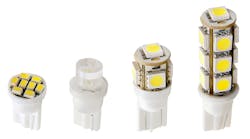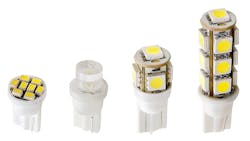Light emitting diodes (LEDs) are popping up in more and more places as companies and individuals try to save money and reduce energy consumption. But some people insist there are problems with them. Here are a three of the myths that have arisen around LEDs:
Myth 1: LEDs will make you go blind.
An article in a recent issue of the Journal of Photochemistry and Photobiology detailed a study in which the effects of LED light on human retinal cells were examined and concluded that LEDs can harm human eyes. The authors of this article came to this conclusion based on an experiment that exposed human retinal cells to 5 mW per cm2 of light from an LED for 12 hr. This equates to staring at a 100-W-equivalent light bulb from four inches away for 12 hr.
Light at that intensity and duration would likely damage anyone’s retinas and is one reason parents tell kids not to stare at the sun. And if scientists ever do discover a real danger from LEDs, future LEDs can be tuned to emit a spectrum of light similar to that from ordinary incandescent bulbs
Myth 2: Blue LEDs are especially dangerous.
There’s a whiff of truth to this one. The human eye doesn’t handle blue light well, especially bright blue light. It can cause mild and temporary headaches and nausea. But if exposure is long enough, it could permanently damage the eye. The source of the blue light—LED, incandescents, or neon—doesn’t matter.
Some overly cautious folks point out that many LED-makers use a primary blue LED and phosphor-down-convert it to get a white LED. They then leap to the conclusion that down-converted blue LEDs will damage eyes or even cause cancer So far, there’s no proof of this.
There is proof, however, that blue LEDs lower melatonin levels, which can weaken a person’s immune system. Medical science does not yet know if an LED-weakened immune system can lead to cancer.
To be on the safe side, many companies are limiting or eliminating the use of blue LEDs for common features such as backlighting TV screens and power buttons on electronic devices. There are also LED makers using primary violet LEDs as the basis for white-emitting lamps.
Myth 3: LEDs aren’t bright enough and have poor light quality.
This was true at one time, but no more It can be refuted with some technical specs. LEDs have color temperatures ranging from 2,500K (warm white) to 6,500K (daylight), and Color Rendering Indexes between 75 and 85, with some high-end LEDs topping 90. (Incandescent bulbs have a CRI of 100 by definition, the highest possible value. For comparison, low-pressure sodium lights have a CRI of -44; Coated mercury vapor’s CRI is 49, Tri-phosphor warm-white fluorescents have a CRI of 73,; and quartz metal halide lamps rate an 85 CRI.)
Traffic engineers also think LEDs are plenty bright. They go into traffic signals which must be visible in the brightest sunlight. Traffic and auto engineers also use LEDs on vehicle headlight and tail lights, and to illuminate tunnels and other roadways. LEDs are also used to light up entire buildings and large rooms.

